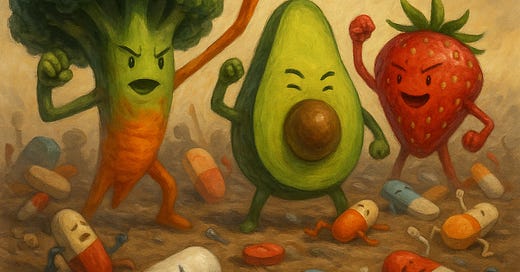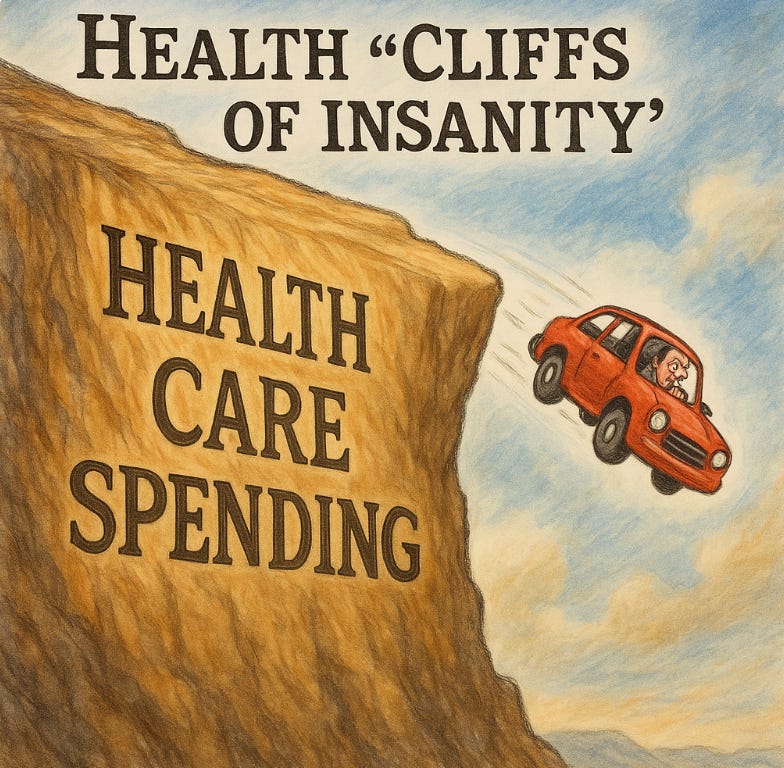I was searching through the many essay’s I’ve written over the decades and never published. I have 1000’s of pages on my Evernote that I will be combing through over the next year to share some thoughts and ideas I’ve had over the the years. This one was amazing. Given the movement with
and pushing this forward over the last decade, I’m surprised how prescient this essay was. I made some edits and updates. Enjoy.August 14th,1998
I’m a doctor. I trained at one of the best institutions, took an oath, learned the intricacies of the body, the chemistry of drugs, and the poetry of diagnosis. And yet, I find myself utterly powerless to prescribe the most basic intervention I know will save lives: real food.
If a patient walks into my clinic with early-stage diabetes, I can prescribe metformin without a blink. I can reach for statins, SSRIs, PPIs—take your pick. But can I write a prescription for lentils and spinach? For wild salmon, blueberries, or a handful of peanuts? Not unless I want to be laughed out of the pharmacy.
The absurdity is systemic. Our healthcare system is built on illness. Health, in this paradigm, is simply the absence of disease—a negative definition for something that should be robust and vital. And yet, despite mountains of evidence that food is foundational to preventing and even reversing chronic disease, the system subsidizes pills while ignoring produce.
Let me be clear: I’m not anti-drug. I prescribe them when they’re needed. But most of what I treat—hypertension, diabetes, heart disease, even depression—is dietary in origin. These are diseases of excess and deficiency: too much sugar, salt, and processed fat; too little fiber, micronutrients, and phytochemicals. And the tragedy is, we know this. It’s not even controversial.
I once joked—half-seriously—that if I could prescribe bananas and peanuts with a $5 co-pay, people would eat more bananas and peanuts. It’s not about access to information. My patients know what they should eat. It’s about what’s easy, what’s affordable, and what’s reinforced by the system. Right now, the average patient is nudged toward a pharmacy, not a farmers market.
The FDA regulates both food and drugs, yet their attention skews dramatically toward the latter. We subsidize corn, which turns into high-fructose syrup, which turns into chronic illness, which turns into billions in prescriptions. The loop is as vicious as it is profitable—for everyone but the patient.
Processed food is no longer a luxury. It’s the default. Once a marker of affluence, “factory food” has become the only viable option for working families. And the richer you are, the more likely you are to shop organic, eat clean, and avoid the very products that the rest of America survives on. The food hierarchy flipped, and health followed.
So here we are: swimming in pills, drowning in disease, and calling it healthcare.
We’re not just facing a fiscal cliff—we’re teetering on a health cliff. Obesity, diabetes, cardiovascular disease: these are not anomalies. They are the predictable consequence of what happens when food becomes stuff, and medicine becomes profit.
Let me offer a counter-vision: a system where a prescription for beans carries the same weight as one for beta blockers. Where insurers reimburse for dietary interventions, cooking classes, and fresh produce delivery. Where “preventive medicine” isn’t code for annual labs and check-the-box screenings, but a sincere, sustained investment in the upstream determinants of health.
This is not fantasy. The data is finally here. A 2012 study in Archives of Internal Medicine showed that eating legumes reduced HbA1c in diabetics. Said differently: eating beans worked as well as—or better than—a drug. It’s time we align our incentives with our biology.
We can either continue patching up metabolic wreckage with expensive pharmaceutical duct tape, or we can start with the root cause: what we eat.
Call me crazy, but I believe that health starts at the table, not the pharmacy.
Let me write that prescription!
I have since gone on to co-found EatReal, a non-profit that is turning this into a reality.
We are doing farm to school and changing the menu of the largest food company in the United States (bigger than Subway, McDonalds and Starbucks combined) - our public schools.
Served: 129 million meals a year
Since 2019, EatReal has helped more than 600 schools put real food on their school menus. That means up to 129 MILLION nutritious, delicious breakfasts and lunches in the last year alone, made accessible to 360,000 kids! Our program is offered to public school districts free of charge. Want to help us reach more states and more kids?
If you’re inclined, any donation would be amazing.









Thanks for sharing, very true! Now big food has a real opponent in big pharma and the ultra processed foods can battle it out with Ozempic et al. So sad..
I was fortunate to have worked in Munich, at that time, West Germany during the 80s and early 90s. For a guy who spent most of his life living in the metro NYC area, my entire life-style changed from living overseas. … and when it came to food, ‘real’ was the magic ingredient. And I ate all my Bavarian favorites like Schweinshaxe, Leberkäse and Weißwürste along with my favorite German beers. If I ate at a McDonalds two times in the more than ten years living there, that was a lot. Probably just to eat their french fries. So you could say my only restrictions were eating any processed foods. The fact that whenever any Europeans came over to work at our U. S. Headquarters for any length of time, say six months or more, they developed American pot bellys around their mid-sections. Why don’t you team up with RFK and put even more pressure on these large food processing corporations? For our children’s and future generations sake?
😊🙏😇